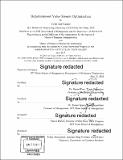| dc.contributor.advisor | Daniel Frey and Steven Spear. | en_US |
| dc.contributor.author | Capps, Tyler Lee | en_US |
| dc.contributor.other | Leaders for Global Operations Program. | en_US |
| dc.date.accessioned | 2017-09-15T15:36:10Z | |
| dc.date.available | 2017-09-15T15:36:10Z | |
| dc.date.copyright | 2017 | en_US |
| dc.date.issued | 2017 | en_US |
| dc.identifier.uri | http://hdl.handle.net/1721.1/111483 | |
| dc.description | Thesis: M.B.A., Massachusetts Institute of Technology, Sloan School of Management, in conjunction with the Leaders for Global Operations Program at MIT, 2017. | en_US |
| dc.description | Thesis: S.M., Massachusetts Institute of Technology, Department of Mechanical Engineering, in conjunction with the Leaders for Global Operations Program at MIT, 2017. | en_US |
| dc.description | Cataloged from PDF version of thesis. | en_US |
| dc.description | Includes bibliographical references (page 55). | en_US |
| dc.description.abstract | One of Company X's many services is to refurbish systems at regular intervals during their use. Quick turnaround times are of the utmost importance both to keep Company X's costs low and to ensure the systems are returned to perform their services in the field as rapidly as possible. This research had two distinct elements in service to accelerated turnaround times: 1) Improving inventory management practices to align with the need for replacements for failed parts to reduce cycle times, and 2) Diagnosing the reasons for and developing mitigations against failures in the blind mating of two connectors. Regarding the first element of the research performed, Company X hypothesized that improving the inventory management system would yield shorter cycle times. In order to test this hypothesis, part failure and inventory histories needed to be compared to confirm if parts were not in stock at the time of failure. A model was developed to analyze both of these history files but the poor quality of the data precluded accurate conclusions from being drawn. Once the data input methods have controls placed on them, the model will serve to accurately represent the failure rates and types of failures of all parts, allowing for proper stocking of inventory needed to service these failures. An investigation of process failure rates and their impact on cycle time was also conducted. This analysis included quantifying how many times each operation was performed, at which steps failures occurred or were noticed most, and how much time was required to complete each operation and service each failure. This analysis ultimately yielded the generation of a diagnostic tool with a flexibility that allowed simultaneous analysis to be performed on over 1,100 operations. One of the key insights generated by using this tool was that the majority of failures are found at late-stage inspections, highlighting that improving the thoroughness of early-stage inspections could prevent the necessity of substantial rework to remedy the issues found late in the process. With respect to the second element of the research performed, an understanding of why and how connectors were failing was sought out. Through observing the process and analyzing the historical data detailing the connector's failure modes, multiple explanations for the failures and related solutions resulted. The first failure mode was loose connections, for which a tool was shortened to increase the operator's ease of accessing the connector to properly apply torque and secure the connection. The other modes of failure were caused due to connector misalignment, for which a bracket was redesigned as an auto-alignment feature to aid in the mating process, and operator deviations from the work instructions were addressed as they pertained to connector failures. The combination of these actions are expected to yield an annual savings of $100,000, net of costs. | en_US |
| dc.description.statementofresponsibility | by Tyler Lee Capps. | en_US |
| dc.format.extent | 55 pages | en_US |
| dc.language.iso | eng | en_US |
| dc.publisher | Massachusetts Institute of Technology | en_US |
| dc.rights | MIT theses are protected by copyright. They may be viewed, downloaded, or printed from this source but further reproduction or distribution in any format is prohibited without written permission. | en_US |
| dc.rights.uri | http://dspace.mit.edu/handle/1721.1/7582 | en_US |
| dc.subject | Sloan School of Management. | en_US |
| dc.subject | Mechanical Engineering. | en_US |
| dc.subject | Leaders for Global Operations Program. | en_US |
| dc.title | Refurbishment value stream optimization | en_US |
| dc.type | Thesis | en_US |
| dc.description.degree | M.B.A. | en_US |
| dc.description.degree | S.M. | en_US |
| dc.contributor.department | Leaders for Global Operations Program at MIT | en_US |
| dc.contributor.department | Massachusetts Institute of Technology. Department of Mechanical Engineering | |
| dc.contributor.department | Sloan School of Management | |
| dc.identifier.oclc | 1003322299 | en_US |
